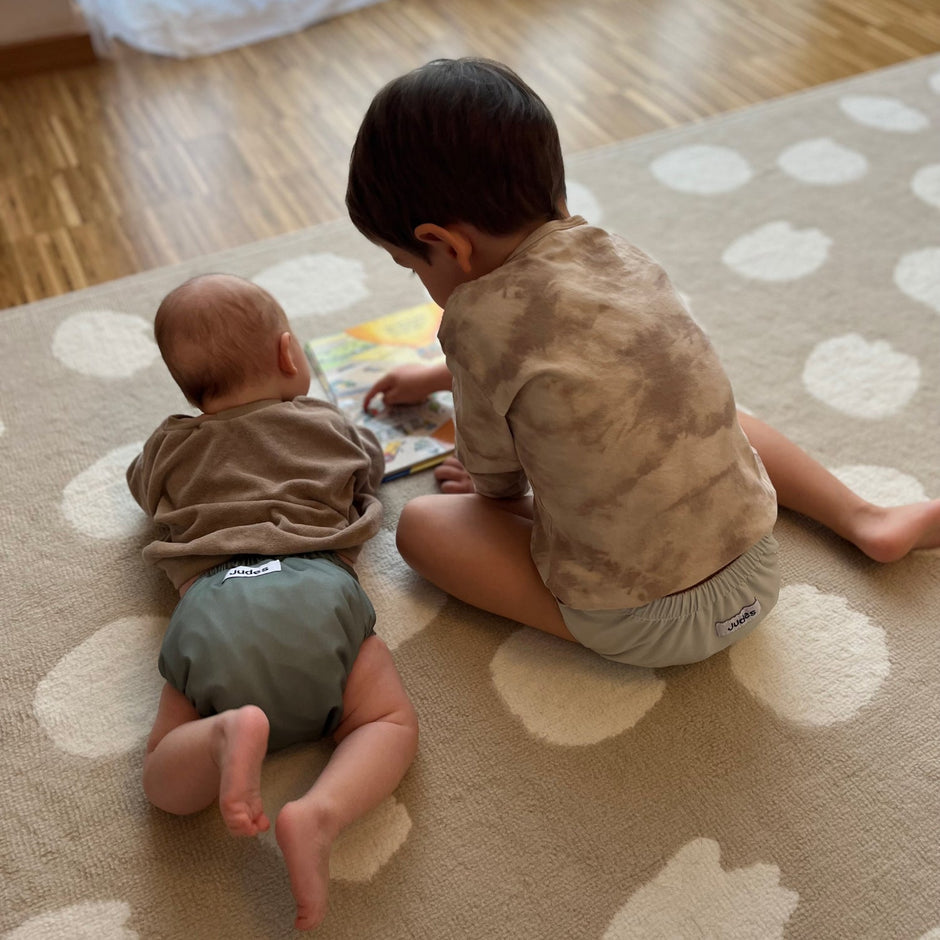Sustainability from Day One - What Does My Baby Really Need?
Updated on:
Photo by @igel.naeherei
Expecting a baby? Congratulations! You're probably wondering what your baby needs once they arrive in the world. It's not uncommon for parents to be full of anticipation and eagerly buy everything that might be useful. Often, half of these items go unused and reveal themselves as unnecessary purchases. If you'd like to know what you really need in the first days with your baby and how to incorporate sustainability into your daily life from day one, then you've come to the right place.
What are the first things a baby needs? In the early days, your baby needs a temperature-appropriate basic set of clothes, a sleeping and changing place, muslin and molton cloths, and a cozy blanket. For the expectant mother, nursing pads and nursing bras are also necessary, and for drivers, a suitable baby car seat.
Below, we provide you with 7 valuable tips for sustainable living with your baby. We will show you which equipment you really need and which investments you can avoid.
Sustainable Essentials – what do you need in the first days with a baby?
Sustainability in everyday baby life primarily involves buying only what you really need. Additionally, the products should not harm the environment - neither in production nor in use. At this point, you're probably thinking about the approximately 6,000 disposable diapers and the countless wet wipes that a baby typically uses. However, convenient and practical products such as baby food in jars, various creams, and numerous cute pieces of clothing make sustainable living with a baby challenging for many parents.
Added to this are countless items that are supposed to make parenting easier, but ultimately are completely unnecessary . This article will give you insight into what you and your baby really need in the early days after birth.
Before you go out and spend a lot of money on baby gear, here’s an overview of the 10 most important items to get you started:
- A basic set of clothing suitable for the season in size 50/56
- A sleeping place for the baby
- A changing place for the baby
- Nursing bras and nursing pads
- OR formula and bottles with teats for newborns
- Diaper rash cream and baby oil
- Muslin and molton cloths
- A carrier or sling
- A cozy and breathable blanket
- For drivers: A baby car seat
Here's the opposite: The 10 most unnecessary items at the start:
- Baby bathtub
- Baby scale
- Stuffed animals
- (Numerous) pacifiers and bottles
- Baby shoes
- Too much baby clothing
- Baby care products
- Baby water
- Crib and children's room furniture
- Breast pump

Photo by @isabelplett
7 Tips for Sustainability in Everyday Baby Life
In general, life with a baby can be very minimalistic and sustainable . Below, we've compiled some tips on how you can make your life resource-efficient without being too limited. It's absolutely okay if not all of our tips match your ideas of parenthood. We simply want to show you the possibilities you might consider.
A Minimalistic Start
In the beginning, only get the things you really need for the first days and weeks with your baby. You can purchase everything else over time once you have a clear idea of what you actually need. With a selection of clothes and diapers, you'll get through the early days just fine. If you already know that you don’t want to breastfeed, you'll naturally need additional materials to bottle-feed your child.
Additionally, you might decide to buy secondhand or rent clothing packages . To avoid being overwhelmed with clothes and toys by relatives, you can ask for vouchers for your favorite baby shops.
Your Baby's Sleeping Place
Accept the fact that you will not be the ones deciding where the baby sleeps. The expensive crib is rarely used at all in the first few months. No matter how much you've planned for your baby to sleep in their own bed, preferably even in their own room: accept that it won't happen. Babies need closeness and parents short distances. Nowhere will your child sleep as peacefully and feel as secure as right next to you. A sleeping place in the parents' room also makes nighttime breastfeeding and diaper changes easier.
Nevertheless, you should certainly think about a safe sleeping place. Bedside cribs that are open to the parents' bed are highly recommended. This way, your child has their own safe sleeping area but is still close to you. If the bedside crib is refused, you can still use it perfectly as a storage place for spare diapers and similar items.
Save your money on an expensive crib—or even an entire nursery. I was so proud when my son's room was finally set up. We entered it solely for changing diapers during the first year. He has slept with us in the family bed from birth; the crib was only used to safely place him when I needed free hands. Yes, a cupboard for storing children's clothes is beneficial, but everything else can wait.

Photo by @ammenmaerchen
The Changing Place
It's clear: You need a changing place. A place where you can safely change your child and have all materials within reach. Consider whether it really needs to be the fancy and expensive changing table, or if a towel on the couch and a small cabinet might suffice.
In my case: Yes, with the first child I enjoyed using the changing table. Everything was in one place and it was a cozy spot for my son. It wasn't until my daughter was born that my perspective changed. Often, the trip from the living room to the children's room was too far, so we moved the changing place into the living room within the first few weeks. Two baskets held spare diapers and care products, and changing took place on the couch or the floor—our advantage here was the underfloor heating. Initially, we used a waterproof pad, but later a towel sufficed. In winter or for temperature-sensitive children, a heat lamp can also help to make changing as comfortable as possible. Conveniently, we initially opted for a changing table that could easily be converted into a dresser, thus becoming storage space for diapers, clothes, and accessories.
Washable Wet Wipes, Changing Pads, and Nursing Pads
With the right tools, you can avoid a lot of waste while living with your baby. Unfortunately, many everyday items are designed for single use. Wet wipes, changing pads , and nursing pads not only contain plastic and often chemicals, but they are disposed of after just one use. The alternative is so simple and also much healthier.
Wet wipes can easily be replaced with washcloths. You have various options to choose from:
- Regular washcloths,
- special washcloths for changing,
- or a small cut-up towel.
If you choose the washable alternative to wet wipes, you benefit from multiple advantages besides avoiding waste:
- You save money! Once purchased, you can use the cloth wipes throughout the diapering period. If you decide, for example, to cut up an old towel, the acquisition costs are zero.
- Naturalness. Classic wet wipes are often infused with fragrances and other ingredients that don't belong on a baby's bottom. With washable wipes, you have control over what comes into contact with your child's intimate area. You can use clean water or add a drop of baby oil for care.
- Always warm, always ready: Cleaning with washcloths is not cumbersome at all. I fill a small thermos with warm water in the morning and place it at the changing spot. This way, it's immediately available, and you spare your child the coldness of traditional wet wipes. Especially when changing diapers at night, babies are very sensitive to temperature. A warm and soft cloth just feels better than a cold wet wipe.
For nursing pads, there are now very discreet, washable alternatives. For example, I've been using my 8 pairs of cloth nursing pads for more than three years.
Complementary Food at the Family Table
Even though reaching for ready-made baby jars may seem convenient, instead of buying or making purees, you can offer your baby what's on the family table once they are ready for solids. Just make sure that the food is as low in salt and baby-friendly as possible. The food should be easy to grasp and chew. The rule is: about as long and thick as your little finger and easy to mash with fingers. Besides steamed vegetable sticks, you can also offer your baby pancake strips, bread, or other items. Yes, you read that right, it is not necessary to start the complementary feeding period with purees.

Photo by PublicDomainPictures from Pixabay
Elimination Communication After Birth – How It Works
Only about 70% of babies worldwide use diapers. The remaining 30% grow up without diapers from birth, did you know that? Even in our culture, it was once common for babies to be held over a pot or sink based on their signals to do their business. When disposable diapers hit the market in the 1960s, the knowledge of natural infant care gradually disappeared. Since then, the piles of disposable diapers have grown, and sustainability in everyday baby life went out the window.
Just like sleep and nutrition, elimination is one of the basic needs of every baby. It is important to know that by nature, no baby wants to lie in their waste, soil their sleeping place, or their caregiver. Babies are competent enough from birth to signal their need to eliminate, we just stopped listening to them over time.
Even though life entirely without diapers is possible, we don’t expect you to always pay attention to your baby's signals amidst a hectic baby routine. Nonetheless, it's worth practicing elimination communication your baby in so-called standard situations and who knows – perhaps a healthy basis for communication will develop, and you'll venture further into the topic. Standard situations include:
- after sleeping
- after feeding
- after carrying
By practicing elimination communication your baby, you can strengthen the bond with your child, prevent stomach aches, and save diaper waste along the way. We also practiced this with both kids; I can count on one hand the times my son had a bowel movement in his diaper – my daughter was not as clear with her signals. With this method, both children were completely diaper-free by 14 months as they never forgot to perceive and communicate their elimination needs.
Cloth Diapers Instead of Disposable Diapers – How to Achieve Sustainability with Baby
Diapers play an important role in the topic of sustainability. About one tonne of diaper waste is produced per child during the diapering period. You can avoid this waste by choosing cloth diapers. Judes has brought to market a cloth diaper that is easy to use and absolutely sustainable. You can wash the used diapers again and again and even pass them on to other children. If you use cloth diapers for more than one child, they become even more sustainable.
Find out in our blog why cloth diapers are also good for health and how many chemicals are in traditional disposable diapers.
Do you have any other tips for sustainability with a baby? Feel free to leave us a comment!

